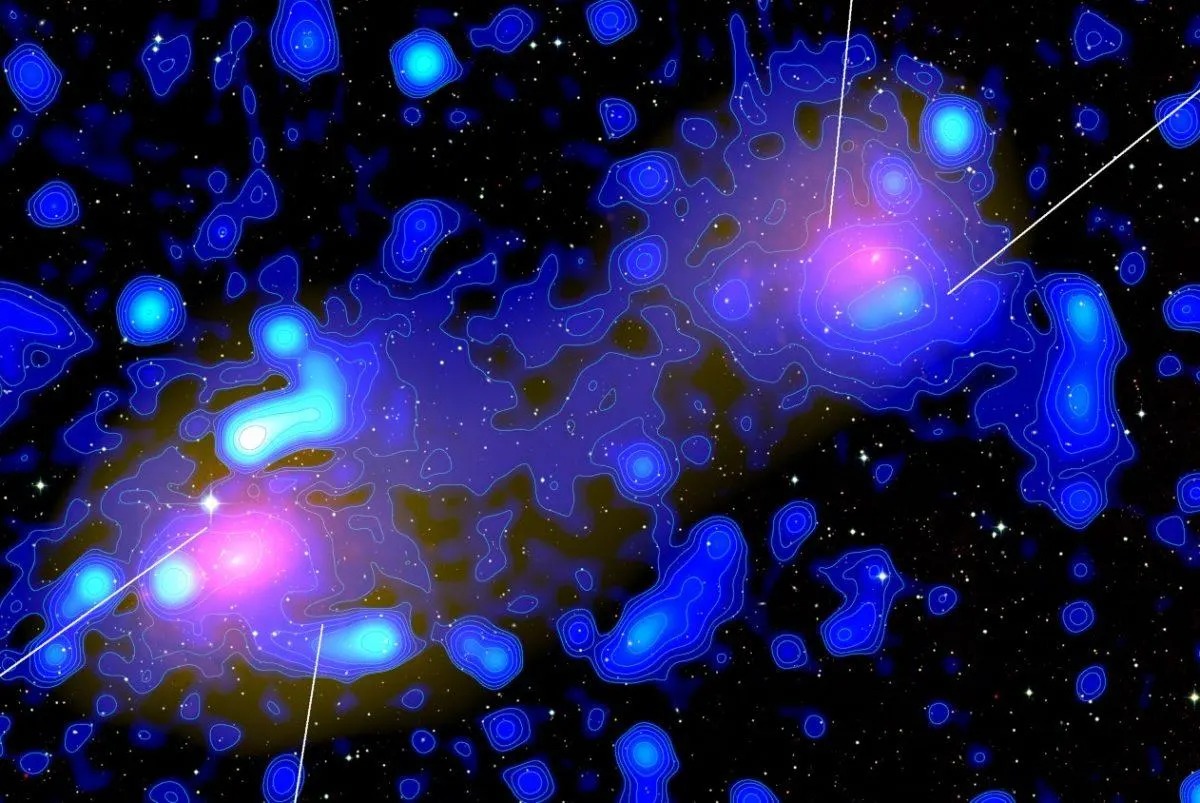
Have you ever wondered what lies between galaxies in the vast expanse of the universe? Intergalactic filaments, also known as cosmic webs, are the answer to this intriguing question. These extraordinary structures are the backbone of the cosmos, connecting clusters and superclusters of galaxies across unimaginable distances.
In this article, we will explore 15 fascinating facts about intergalactic filaments that will leave you in awe of the intricate cosmic architecture. From their immense size and mysterious origins to their role in shaping the distribution of matter in the universe, these filaments reveal the mesmerizing interconnectedness of the cosmos.
So, buckle up and prepare for a mind-bending journey through the universe as we unravel the secrets of intergalactic filaments.
Key Takeaways:
- Intergalactic filaments are like cosmic highways that connect galaxies across the universe, playing a crucial role in the formation and evolution of stars, galaxies, and even supermassive black holes.
- These immense cosmic structures, shaped by dark matter, are essential for understanding the large-scale structure of the universe and hold clues to mysteries like dark energy and the early universe.
Filaments Are the Largest Structures in the Universe
Intergalactic filaments are immense cosmic structures comprising of gas, dust, and dark matter. These filamentary structures span millions of light-years, connecting galaxies across the vast expanse of space.
Filaments Play a Crucial Role in the Cosmic Web
Intergalactic filaments form a intricate network known as the cosmic web, which serves as the backbone of the universe’s large-scale structure. They provide channels for the flow of matter and energy between galaxies.
Filaments Contain a Variety of Cosmic Matter
These cosmic filaments contain a rich tapestry of matter, including hot and diffuse gas, dark matter, and even traces of heavy elements. This diverse cosmic cocktail fuels the formation of stars and galaxies.
Filaments Are Shaped by Dark Matter
Dark matter, a mysterious substance that makes up a significant portion of the universe’s mass, gravitationally influences the shape and distribution of intergalactic filaments. It acts as a scaffolding for the cosmic web.
Filaments Are Hotbeds for Star Formation
Within the dense regions of intergalactic filaments, gas and dust accumulate, providing the ideal conditions for the birth of new stars. These cosmic nurseries contribute to the ongoing evolution of galaxies.
Filaments Act as Highways for Galaxies
Intergalactic filaments serve as cosmic highways, facilitating the movement of galaxies across the universe. Galaxies are often found along these filaments, tracing the intricate web-like structure of the cosmos.
Filaments Can Span Hundreds of Millions of Light-Years
The sheer scale of intergalactic filaments is awe-inspiring. These cosmic threads can stretch across mind-boggling distances, connecting galaxies that are separated by hundreds of millions of light-years.
Filaments Are Difficult to Detect Directly
Due to their extremely low density and diffuse nature, intergalactic filaments are challenging to detect using traditional observational methods. Scientists employ advanced techniques and simulations to study these elusive structures.
Filaments Play a Role in the Distribution of Cosmic Background Radiation
The presence of intergalactic filaments influences the distribution of the cosmic microwave background radiation, providing valuable insights into the early universe and the formation of galaxies.
Filaments May Hold Clues to Dark Energy
Investigating the properties of intergalactic filaments can shed light on the nature of dark energy, the mysterious force driving the accelerated expansion of the universe. Understanding dark energy is a major goal in modern cosmology.
Filaments Can Stretch for Billions of Light-Years
Some intergalactic filaments are so massive that they can extend for billions of light-years. These colossal cosmic structures highlight the vastness and complexity of the universe we inhabit.
Filaments Are Essential for the Growth of Supermassive Black Holes
Intergalactic filaments funnel vast amounts of matter into the cores of galaxies, fueling the growth of supermassive black holes residing at their centers. This process plays a pivotal role in galaxy evolution.
Filamentary Structures Are Traced by Galaxies’ Distribution
By mapping the distribution of galaxies in the universe, scientists can trace the underlying filaments of the cosmic web. This enables us to gain a better understanding of the large-scale structure of the universe.
Filaments Are Integral to the Formation of Galaxy Clusters
Galaxy clusters, the largest bound structures in the universe, are formed through the merging of multiple galaxies along intergalactic filaments. These massive clusters showcase the profound interconnectedness of cosmic filaments.
Filaments Connect Galaxies across Cosmic Time
Intergalactic filaments have been connecting galaxies throughout cosmic history, serving as conduits for the exchange of matter and energy. They provide the structural framework for the universe’s ongoing evolution.
Conclusion
In conclusion, intergalactic filaments are truly remarkable structures in the universe. They play a vital role in the cosmic web, connecting galaxies across vast distances. These filaments are not only immense in size but also serve as highways for matter and energy to flow between galactic clusters.From their role in the formation and evolution of galaxies to their influence on the distribution of dark matter, intergalactic filaments hold many secrets waiting to be uncovered. Scientists continue to study these extraordinary structures, using advanced telescopes and simulations to gain a deeper understanding of their properties and impact on the universe.As our knowledge of the cosmos expands, so does our fascination with intergalactic filaments. Exploring these cosmic highways will undoubtedly lead to more awe-inspiring discoveries, helping us unravel the mysteries of the universe and our place within it.
FAQs
1. What are intergalactic filaments?
Intergalactic filaments are long, thread-like structures that connect galaxies in the universe. They are made up of gas, dust, and dark matter.
2. How large are intergalactic filaments?
Intergalactic filaments can range in size from millions to billions of light-years in length.
3. What is the cosmic web?
The cosmic web is a large-scale structure of the universe, composed of intergalactic filaments and galactic clusters.
4. How do intergalactic filaments form?
Intergalactic filaments form through the gravitational attraction of matter towards regions of higher density.
5. Are intergalactic filaments visible?
While intergalactic filaments are not directly visible, their presence can be inferred through observations of galaxies and the distribution of matter.
6. Can intergalactic filaments be traveled through?
As of now, intergalactic filaments are only theoretical highways for matter and energy to move between galactic clusters.
7. What role do intergalactic filaments play in galaxy formation?
Intergalactic filaments provide the necessary fuel for the formation and growth of galaxies by funnelling gas and matter towards them.
8. Are intergalactic filaments uniform in structure?
No, intergalactic filaments can vary in density and composition along their length.
9. How do scientists study intergalactic filaments?
Scientists study intergalactic filaments through observations using telescopes and computer simulations.
10. What is the significance of understanding intergalactic filaments?
Understanding intergalactic filaments is crucial for comprehending the large-scale structure and evolution of the universe.
Intergalactic filaments are truly awe-inspiring, but there's so much more to explore in the vast expanse of the cosmos. Dive into the fascinating world of astrophysics and uncover the secrets of the Universe. Unravel the enigma of dark matter and its profound influence on cosmic structures. Embark on a captivating journey through the process of galaxy formation and witness the birth of celestial wonders. Each topic offers a unique perspective on the intricate tapestry of our Universe, inviting you to expand your knowledge and marvel at the extraordinary phenomena that shape our existence.
Was this page helpful?
Our commitment to delivering trustworthy and engaging content is at the heart of what we do. Each fact on our site is contributed by real users like you, bringing a wealth of diverse insights and information. To ensure the highest standards of accuracy and reliability, our dedicated editors meticulously review each submission. This process guarantees that the facts we share are not only fascinating but also credible. Trust in our commitment to quality and authenticity as you explore and learn with us.


